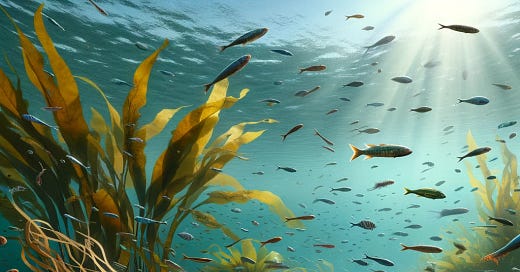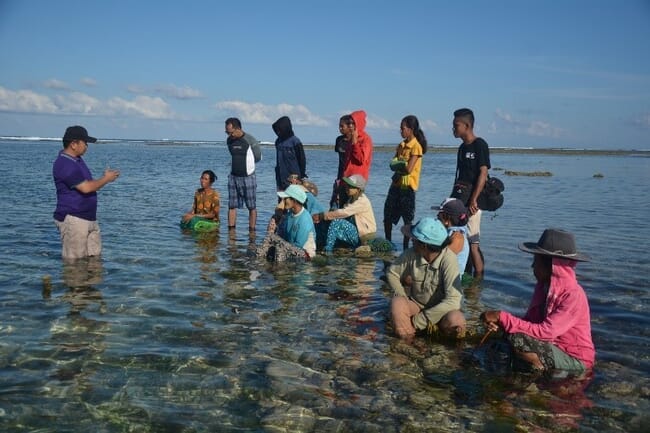🌊 Nestlé Purina Europe aims to restore 1,500 hectares of marine habitats by 2030
PLUS: The European Union approves more than 20 algae species for food, and Dutch microalgae producer Phycom secures €1.75M.
“This patent enables us to uniquely make and protect the claims over these performance improvements and how they are achieved, which is through the specific prebiotic effect our product has in the microbiome of the animals.” — Mark Williams, CEO, Ocean Harvest Technology
Dear seaweed and microalgae investors, buyers, operators, and technologists, welcome to another edition of the Paxtier Report!
Food for thought this week…
I recently updated my essay on Japan’s blue carbon calculations and fleshed out my thoughts on several key areas, including:
→ The real meaning behind the move,
→ A possible methodology,
→ Challenges and questions remaining, and
→ Why it matters.
In response to the article, Brian Tsuyoshi Takeda added some valuable insights which I’d like to share with you here to add some more context:
“It’s important to note that this was a top-down initiative from day one, where the Ministry of Infrastructure dictated to the market that the “Japan Blue Economy Association” will be THE institution that will be responsible for blue carbon, full stop. By taking such a top down approach, there was genuine authority and credibility behind the organisation. There were no other competing actors to confuse the market, or sow the seeds of uncertainty by having multiple, credible bodies trying to out-compete each other in terms of authority and legitimacy. This effectively brought all the risk averse corporates in line from the start.”
“Secondly, while there are aspects of the carbon calculation methodology that can be debated - that is the scientific process. And as the science gets better, the methodology, including the MRV (like it already has) gets updated and improved. JBE has a standing scientific panel that looks to improve this continually, so I think this kind of discussion is very healthy for its evolution. Let’s also not forget to look at the wider issue, which I think is about creating a credible system that project developers, funders, and civil society can believe in and support.”
“Finally, while the Japanese methodology is certainly based on carbon, in the submission process, we are given the opportunity to describe the co-benefits to biodiversity and society. These quantitative and qualitative arguments we include do not change the carbon sequestered but change the value of the credit to buyers.”
Well said, Brian. The final two points about valuing more than carbon and refining the MRV process are particularly important - aligning closely with this week’s major announcement from Nestlé Purina Europe, as the organisation launched its first Ocean Restoration Program, aiming to restore 1,500 hectares of marine habitats by 2030 to help support marine biodiversity.
“Purina is investing in its partners' ocean restoration solutions across Europe, with the aim of making these effective and scalable. Each partner targets species that are critical to restoring local marine habitats but are being depleted. The first phase of the program will last three years and prioritises the development of research, a measurement framework and the conditions needed to scale up the restoration solutions efficiently and effectively. The second phase is planned to start in 2026 and will focus on scaling the proven solutions.”
Well done to Lisa and the wider team for this remarkable initiative - exciting times ahead.
Have a great day.
— Peter
In today’s report…
Markets: 📈 The European Union has approved more than 20 algae species for sale as food or food supplements.
Deals: 🤝 Dutch microalgae producer Phycom secures €1.75M from ROM Utrecht Region and a private investor.
Movers and Shakers: 🌊 Pratt Institute's AquaSteady project receives a $5 million NSF award for its innovative use of seaweed-based hydrogels in agriculture.
Around the web: 🌿 Cornwall Council reports the discovery of large maerl beds.
Markets and Investing
✂️Algae Market Snippets
Some big moves in recent weeks…
General
🌿 The European Union has approved more than 20 algae species for sale as food or food supplements which could offer both cost savings and faster market access (Read more HERE).
🌊 A new initiative called the Blue Venture Builder launches in Africa (Read more HERE).
🌍 The European Parliament has just passed a Nature Restoration Law, aiming to restore 20% of the EU's land and seas by 2030 (Read more HERE).
Seaweed
💸 Seaworthy Collective secures climate tech investment from Biden administration (Read more HERE).
💸 Pratt Institute's AquaSteady project receives a $5 million NSF award for its innovative use of seaweed-based hydrogels in agriculture (Read more HERE).
🌊 Alaska's mariculture industry experiences significant production growth in recent years, particularly in farmed shellfish and seaweed (Read more HERE).
🌊 The Bureau of Fisheries and Aquatic Resources in Romblon, Philippines, introduces market-related activities to support local fisherfolk (Read more HERE).
🌿 Hong Kong's Centre for Food Safety investigates a seaweed product imported from Japan suspected of violating the Food Safety Order (Read more HERE).
🌿 Ocean Harvest Technology hails the grant of a new patent for its seaweed-based animal feed product OceanFeed as a significant milestone (Read more HERE).
🌊 The Nature Conservancy (TNC) has published a framework for restorative aquaculture (Read more HERE).
🌍 The Blue Carbon Academy has been launched by Fair Carbon, a Swiss-based nonprofit (Read more HERE).
💸 The Sussex Bay Restoration Project receives a £100,000 grant to rejuvenate a 100-mile coastline (Read more HERE).
🌿 SeaStock announces the “significant milestone of close to 100% extraction efficiency of naturally derived bromoform” (Read more HERE).
🌿 Origin by Ocean announces open call for seaweed suppliers to feed biorefinery expansion (Read more HERE).
🌿 MinDA, BARMM, European Union, and UNIDO switch on Mindanao’s first hybrid power plant (Read more HERE).
🤝 Olmix Philippines collaborates with the University of the Philippines Visayas to support academic excellence and seaweed research (Read more HERE).
🌊 Oceanium has published its 2023 Impact Report (Read more HERE).
🤝 Somater and Eranova work together to produce biobased packaging derived from green algae (Read more HERE).
🌊 The University of Queensland has developed a new offshore cage technology, SeaFisher, aimed at expanding farming into deeper ocean regions (Read more HERE).
Microalgae
🤝 Cementos Argos has partnered with Ecopetrol, EAFIT, and the University of Antioquia to develop a method of carbon capture using microalgae (Read more HERE).
💸 Dutch microalgae producer Phycom secures €1.75M from ROM Utrecht Region and a private investor (Read more HERE).
🟢 Saudi researchers at King Abdullah University of Science and Technology (KAUST) have developed a new method to produce microalgae in large volumes (Read more HERE).
🟢 Goondiwindi algae farm scores important food grade certification in an Australia-first (Read more HERE)
🟢 VINPAI introduces VIN'FIBR'ALG® - algae and plant fibres for the food industry (Read more HERE).
🐦Tweets of the week
🔥 What else was hot in seaweed and microalgae this week?
Seaweed
🌊 A study by the University of Gothenburg suggests that yeast and kelp flies, cultivated on by-products from the seafood industry, could replace fishmeal and soybeans in fish feed (Read more HERE).
🌊 The Blue Food Innovation Summit is set to return to London in May 2024 (Read more HERE).
🌿 The Seaweed Alliance announces the release of its Project Madoc results: exploring the feasibility of developing a seaweed industry in Wales (Read more HERE).
🌿 Can seaweed stop us ingesting microplastics? (Read more HERE).
🌊 Find out more from The European Maritime Spatial Planning Platform on a project cultivating seaweed in the FINO2 Platform in the Baltic Sea (Read more HERE).
🧪 (Paper) The optimization of Co3O4 nanoparticles for enhancing biomethane production from seaweed (Read more HERE).
🌿 Seaweed farmers feature in the work of Thomas Liera, Forbes (top left)…
🌿 Exploring skin care with sustainable seaweed and algae innovations featuring fucoidan extracts (Read more HERE)
🌿 Cornwall Council reports the discovery of large maerl beds. Maerl is highly effective in storing carbon, estimated at 841 tonnes of CO2 annually (Read more HERE).
🌿 The otter, the urchin and the Haida (Read more HERE).
🌿 Biotic triumphs in Continental’s Climate Solutions Prize (Read more HERE).
Microalgae
🟢 A recent study has highlighted a significant 'green transition' in glacier-fed streams, where the shrinkage of glaciers is leading to an increase in microbial life (Read more HERE).
🤝 NewFish, in collaboration with the Cawthron Institute, unveils a diverse collection of native microalgae strains from New Zealand (Read more HERE)
🟢 Recent research reveals that nitrogen's role in lake ecosystems has been underestimated (Read more HERE).
🌍 Duke University's decision to close major plant collection sparks outrage (Read more HERE).
🧪 A study suggests Chlorella may improve exercise tolerance and recovery (Read more HERE).
That’s all folks!
Thanks again for joining us this week. Hope you have a great day and stay tuned for more seaweed and microalgae updates soon!
Best,
Peter











